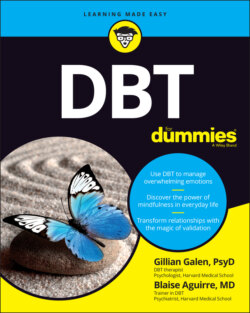Читать книгу DBT For Dummies - Gillian Galen - Страница 17
Surveying DBT Skills
ОглавлениеDBT assumes that many of the problems that people experience occur because they don’t have, or can’t effectively use, the skills to manage emotionally charged situations. More specifically, the failure to use effective behavior when it’s needed is often a result of not knowing skillful behavior or, if known, how to use it. Consistent with this idea of skills deficit, the use of DBT skills during standard treatment — in group, individual therapy, and coaching — has been found to lead to a reduction in suicidal behavior, non-suicidal self-injury, and depression, and to improve emotion regulation and relationship problems. In Part 3, we thoroughly review these skills:
Mindfulness: In part derived from Zen and mystical meditative practices, DBT teaches people the importance of how to be mindful. It involves reflecting on two considerations: “What do I do in order to practice mindfulness?” and “How do I practice these mindfulness skills?”
Interpersonal effectiveness: DBT teaches more effective ways for people to get what they need and what they want, how to reduce interpersonal conflict, how to repair relationships, and how to say “no” to unreasonable requests. The focus is on helping a person build self-respect, improve their self-advocacy, and recognize their needs as valid.
Distress tolerance: Whereas many approaches to mental health treatment focus on changing stressful situations, DBT focuses on teaching people skills that allow them to tolerate these situations, which are often fraught with emotional pain or distress. Within the skills, there is also a recognition of the importance of distinguishing between accepting reality as it is and approving of this reality.
Emotion regulation: Central to many of the problems in which DBT is effective is the finding that people who struggle with regulating their emotions lack the ability to do so effectively. The focus of this skills module is to get people to know what emotion they are experiencing, what the vulnerability factors are to dysregulated emotions, what the functions of emotions are, and then how to deal with the emotions when they are disproportionate to the situation.
